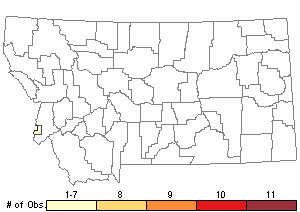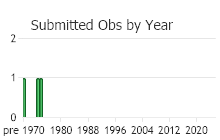View in other NatureServe Network Field Guides
NatureServe
Montana
Utah
Wyoming
Idaho
Wisconsin
British Columbia
South Carolina
Yukon
California
New York
Evermann Fleabane - Erigeron evermannii
State Rank Reason (see State Rank above)
Rare in Montana, where it is currently known from two alpine peaks in the Bitterroot Mountains. Available data are based on specimen collections from the 1960's and 1970's, though there is no reason to believe that these populations no longer exist or that they have been negatively impacted. More current data are needed.
General Description
Evermann Fleabane is a dwarf perennial. Its stems reach up to 10 cm high and arise from a branched rootstock and from a long, deep-seated taproot. The glabrous basal leaves are up to 4 cm long, spoon-shaped, and rounded at the tips. The stem leaves are greatly reduced or lacking. The flowering heads are solitary at the ends of the stems. The rays that compose the petals of the flowering head are 6-10 mm long and white or occasionally light blue. The involucral bracts are 5-8 mm long, spreading hairy, and usually glandular. The achenes have 25-35 unequal-length bristles, forming a pappus, at the top.
Phenology
Flowering in July-August.
Diagnostic Characteristics
Erigeron is a large and difficult genus to distinguish. The tap-rooted habit, triple-nerved basal leaves, stem pubescence, almost complete absence of stem leaves, and the shifting talus habitat are good distinguishing characters for E. evermannii.
Species Range
Montana Range
Range Descriptions

 Native
Native
Range Comments
Central ID to southwest MT. Regional endemic.
Observations in Montana Natural Heritage Program Database
Number of Observations: 7
(Click on the following maps and charts to see full sized version)
Map Help and Descriptions
Relative Density

Recency



 (Observations spanning multiple months or years are excluded from time charts)
(Observations spanning multiple months or years are excluded from time charts)
Habitat
Shifting talus slopes and dry, rocky meadows near or above timberline.
Ecological Systems Associated with this Species
- Commonly Associated with these Ecological Systems
Alpine Systems
Ecology
POLLINATORS The following animal species have been reported as pollinators of this plant species or its genus where their geographic ranges overlap:
Bombus bifarius,
Bombus centralis,
Bombus fervidus,
Bombus flavifrons,
Bombus huntii,
Bombus melanopygus,
Bombus mixtus,
Bombus rufocinctus,
Bombus occidentalis, and
Bombus insularis (Thorp et al. 1983, Wilson et al. 2010, Colla and Dumesh 2010, Koch et al. 2012).
Threats or Limiting Factors
STATE THREAT SCORE REASON
Threat impact not assigned because threats are not known (MTNHP Threat Assessment 2021).
References
- Literature Cited AboveLegend:
 View Online Publication
View Online Publication Colla, S.R. and S. Dumesh. 2010. The bumble bees of southern Ontario: notes on natural history and distribution. Journal of the Entomological Society of Ontario 141:39-68.
Colla, S.R. and S. Dumesh. 2010. The bumble bees of southern Ontario: notes on natural history and distribution. Journal of the Entomological Society of Ontario 141:39-68. Koch, J., J. Strange, and P. Williams. 2012. Bumble bees of the western United States. Washington, DC: USDA Forest Service, Pollinator Partnership. 143 p.
Koch, J., J. Strange, and P. Williams. 2012. Bumble bees of the western United States. Washington, DC: USDA Forest Service, Pollinator Partnership. 143 p. Thorp, R.W., D.S. Horning, and L.L. Dunning. 1983. Bumble bees and cuckoo bumble bees of California (Hymenoptera: Apidae). Bulletin of the California Insect Survey 23:1-79.
Thorp, R.W., D.S. Horning, and L.L. Dunning. 1983. Bumble bees and cuckoo bumble bees of California (Hymenoptera: Apidae). Bulletin of the California Insect Survey 23:1-79. Wilson, J.S., L.E. Wilson, L.D. Loftis, and T. Griswold. 2010. The montane bee fauna of north central Washington, USA, with floral associations. Western North American Naturalist 70(2): 198-207.
Wilson, J.S., L.E. Wilson, L.D. Loftis, and T. Griswold. 2010. The montane bee fauna of north central Washington, USA, with floral associations. Western North American Naturalist 70(2): 198-207.
- Additional ReferencesLegend:
 View Online Publication
View Online Publication
Do you know of a citation we're missing? Lesica, P., M.T. Lavin, and P.F. Stickney. 2012. Manual of Montana Vascular Plants. Fort Worth, TX: BRIT Press. viii + 771 p.
Lesica, P., M.T. Lavin, and P.F. Stickney. 2012. Manual of Montana Vascular Plants. Fort Worth, TX: BRIT Press. viii + 771 p. Lesica, P., M.T. Lavin, and P.F. Stickney. 2022. Manual of Montana Vascular Plants, Second Edition. Fort Worth, TX: BRIT Press. viii + 779 p.
Lesica, P., M.T. Lavin, and P.F. Stickney. 2022. Manual of Montana Vascular Plants, Second Edition. Fort Worth, TX: BRIT Press. viii + 779 p.
- Web Search Engines for Articles on "Evermann Fleabane"





